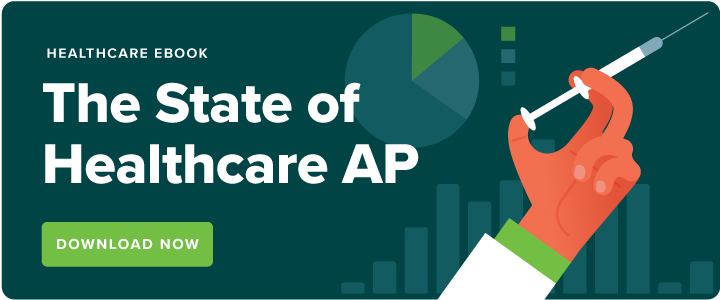Healthcare leaders, trustees, and executives have significant impact on their organization’s finances and processes, and they rely on certain internal financial reports to make decisions. In this article, we will provide a brief overview of healthcare accounting and the power of automation to improve processes for healthcare-focused organizations.

What is Healthcare Accounting?
Accounting is the practice of processing and recording financial transactions. It’s something everyone does on a small scale in their personal lives–we have to know how much money we have coming in and when to expect its arrival in order to make sure we can pay the mortgage on time. Accounting typically includes several departments including accounts receivable and accounts payable, which handle receiving and paying money on behalf of the organization.
Often, we have multiple bills and due dates to keep track of along with everyday expenses such as food and gas. Credit cards may be used to cover an expense that’s due before your next paycheck arrives, and so on. But when it comes to accounting in the business world, keeping track of finances gets a lot more complicated very quickly, which is why accounting is a field of specialization, typically requiring a degree and certification.
With healthcare organizations, money comes in from insurance payments, patient payments, and sometimes grants or other sources. Money goes out to cover wages, supplies, and overhead. But it’s almost never the case that the money to cover expenses arrives at the time the expense is incurred.
Insurance payments may be delayed or require back-and-forth communication, some patients pay late, or can’t afford to pay. All sorts of supplies are needed–some on a regular basis, and some infrequently–and from multiple different vendors who all must be paid. Additionally, healthcare accounts must ensure they are remaining compliant with HIPAA regulations. All of these confounding factors make healthcare accounting a careful balancing act.
What Do Healthcare Accountants Do?
Healthcare accountants are tasked with maintaining the financial records of healthcare organizations. They may work for hospitals, health insurance companies, or private physician practices and are required to comply with federal, state, and local laws and regulations that pertain to accounting and healthcare management.
Day to day tasks of healthcare accountants include:
- Measuring revenues and expenses
- Allocating revenue
- Calculating depreciation
- Generating accounting reports
- Tracking reimbursement
- Developing the budget
- Monitoring financial reporting
One of the most important jobs of healthcare accountants is handling the balance sheet. The balance sheet lists estimates of all assets and debts as well as the difference between total assets and total debts, providing a current estimate of the company’s net worth.
Two essential functions related to maintaining the balance sheet are the accounts receivable and accounts payable departments. AR ensures that payments are received from customers, while AP pays bills to vendors. Reducing errors and increasing efficiencies in both departments is important. However, due to the nature of the pandemic, this has become increasingly important for AP teams. 68.6% of those surveyed noted their work environment has become remote or a hybrid model. Since AP has traditionally focused on manual processes and paper checks, automating these processes is essential for companies looking to reduce errors and increase efficiencies in their accounting departments.
Why is Healthcare Accounting Important?
The primary goal of the healthcare industry is to provide patients with proper care and treatment. But this treatment needs to be cost-effective. The accounting department is responsible for making sure everything on the financial end runs smoothly. Supplies must be sourced that are of sufficient quality without breaking the bank. And, as mentioned previously, the inflow and outflow of money in the healthcare industry comes with complications related to health insurance claims and late or non-payments.
Any healthcare organization that doesn’t stay on top of its finances won’t stay in business for long. When accounting processes fail to be effective or fail to stay with the times in terms of processing efficiencies and technology use, this leads to significant problems. Moreover, handling accounting data and generating reports is vital in this field for proper decision-making.
Essential Accounting Reports
Here we outline some essential accounting reports that inform critical decision-making in the healthcare field. These reports must be timely and accurate so that they can be acted upon with confidence. Together, they provide a detailed picture of an organization’s financial health.
P&Ls
Profit and loss statements, or P&Ls, are financial reports that summarize revenues, costs, and expenses over a specific period of time. These statements are often issued quarterly and annually and are prepared using cash or accrual accounting methods. It is useful to compare P&L statements from different accounting periods in order to observe changes over time, which often offer more insight than a one-time snapshot.
P&L statements are mandatory for all publicly traded companies and must be filed with the SEC. They must also comply with the rules outlined in the generally accepted accounting principles (GAAP).
Balance Sheet
A balance sheet reports a company’s assets and liabilities on the specific date it is published. In contrast to P&L statements, the balance sheet does not show trends over time, and it generally does not make sense to compare the current balance sheet with previous ones.
The information provided in the balance sheet is used to calculate important metrics and financial ratios which are used for analysis. These include:
- Current ratio: the quotient of current assets over current liabilities
- Quick ratio: The difference between current assets and inventories divided by current liabilities
- Working capital: The difference between current assets and current liabilities
- Debt-to-equity: The total liabilities divided by equity
Statement of Cash Flows
The cash flow statement summarizes all forms of cash coming into a company. This includes cash from operations, investment, and financing–which are typically broken down in three different sections within a cash flow report.
This statement provides an overview of all transactions flowing through an organization that contribute to its solvency. It helps with the monitoring of operations, aids investors by providing important financial detail, helps a company determine its current financing needs, and is useful in long-term planning.
Automating Healthcare Accounting Processes
In its 2022 State of AP Report, MineralTree surveyed a wide range of financial professionals. According to the findings accounts payable was the number one priority in terms of digitization and automation. There are a number of reasons why AP is a priority for accounting teams to tackle. 38% of those surveyed noted that supplier payment volumes increased over the last year. Additionally, with the emergence of a hybrid or fully-remote workforce, the need to digitize AP has become more important than ever. Manual paper processes no longer service the organization and create unnecessary hurdles which can result in errors, duplicate billing, and strained vendor relationships. For organizations looking to automate their accounting, AP is a worthwhile place to start.
Examples of Automation in Healthcare Accounting
cCARE Saves 80% of Time Spent on Manual Processes
California Cancer Associates for Research and Excellence (cCARE) is the biggest oncology and hematology practice in the state of California. Their AP team used to rely on manual processes to pay their bills. However, this process was extremely tedious and time-consuming, with over 1,000 invoices a month needing to be processed. Their team would make two check runs a week, with each payment requiring approval. By leveraging MineralTree’s AP automation technology, cCare was able to improve its process and integrate payments automatically with Quickbooks. Additionally, this tool allowed cCare to save 80% of the time spent on manual processes and focus time on other high-value initiatives that were often difficult to juggle due to time constraints.
Cascade Senior Living Services Drives Down Costs
Cascade Senior Living Services helps senior living services tackle the back-end office work so that these centers can focus on their residents. However, this organization was facing challenges due to remote work and manual processes, resulting in challenges with visibility, outstanding invoices, and a few items being paid for twice. Cascade chose MineralTree as an end-to-end AP automation solution. Through MineralTree, they were able to drive down costs, cut down on inefficiencies, and create a more centralized process.
Final Thoughts
Healthcare organizations are under scrutiny as the industry faces increasing pressure to both manage costs and deliver high-level patient care, all while the AP department often deals with manual paper processes. This is where MineralTree comes in. Our AP automation helps healthcare organizations reduce costs, boost efficiency, and redirect efforts to more important concerns.
At MineralTree we have helped healthcare organizations not only drive out inefficiencies in the decentralized invoice collection and approval process; but also, increase employee retention and enhance security measures to prevent breaches by leveraging HIPAA compliant technology. And by providing easy access to invoice status, reports, and audit trails in one central location, we make it easy to generate critical financial reports that can be used to more accurately control, analyze, and predict financial business outcomes.




